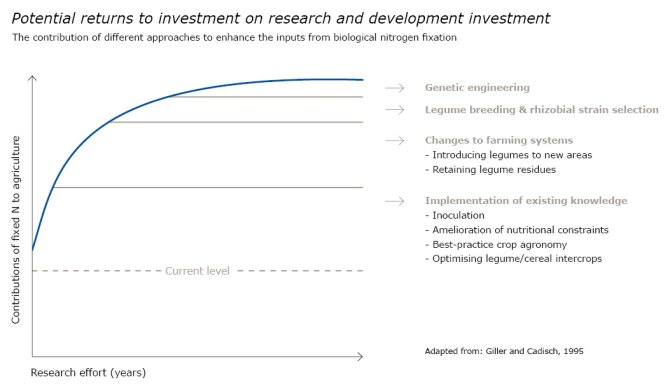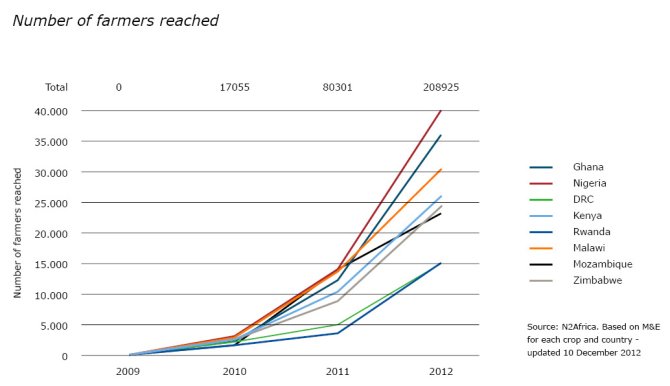Nitrogen fixation
Two spoonfuls of 'black magic powder' can double the yield of an average African field used for growing leguminous plants.
Legume crops such as beans, peanuts and soy can fix nitrogen from the air, and flourish on nitrogen- deficient soils. To do so, they need help from Rhizobium bacteria. These special bacteria stimulate the growth of nodules on the roots of leguminous plants. The bacteria help the plant by extracting nitrogen from the air, while the plant helps the bacteria grow by supplying carbon. It is a perfect symbiosis. Thanks to the bacteria, the leguminous plants are less reliant on (artificial) fertilisers. As a result they form part of the solution for infertile African fields where the harvests are far lower than in the rest of the world. The cause for these low yields is well-known: A lack of inputs such as artificial fertiliser, limited crop diversity, and poor access to knowledge.
Helping small, poor farmers achieve better yields for heir own consumption and to sell at local markets is the most powerful way of combating hunger and poverty around the world.
But legumes are minor crops in Africa. Instead, African farmers mainly grow carbohydrate-rich staple crops such as maize, sorghum, millet and cassava. These crops are unable to perform the nitrogen fixation trick and therefore entirely reliant on nitrogen in the soil. Due to low soil fertility, the harvests lag far behind what is technically feasible. This is where we find the so-called yield gap. Moreover, where the bacteria are naturally abundant in the soil elsewhere in the world, they are often absent in the deficient African soils.
More than 100 years ago, scientists found a relatively simple method for cultivating the bacteria and coating them on seed at planting. Over the past three years, project leader professor Ken Giller introduced new varieties of beans, peanuts, cowpea and soya in eight African countries with the support of the Gates Foundation. Over 200,000 small-scale farmers south of the Sahara saw their land yield increase and sometimes even double thanks to a few spoonfuls of peaty powder in which the bacteria thrives. The local population in Ghana lovingly call it black magic while the scientists speak of inoculants and call the project N2Africa.

System analysis
Although the project had its origins in the desire of the Bill & Melinda Gates Foundation to generate direct results, Giller has shifted from a 'best bet' to a 'best fit' solution in which the scientists first look at the current agricultural methods and enable farmers to try out new technologies. By comparing the experiences in the eight different countries, it will become clear how farmers can best apply the nitrogen fixing bacteria and adapt other production increasing technologies at a local level. The project also looks at how the legume crops can improve operational management, income and food supply for the farmers’ families.
The bacterial inoculants are produced in partnership with the local industry, taking into account quality standards that were developed for their production. By using simple techniques, African farmers can add the bacteria and a small amount of nutrients to the soil when sowing their fields. To ensure the cultivation is successful, they must also apply the best available varieties of the legume crops and an improved crop management. Soil infertility is analysed per region and tackled with organic manures, backed up by artificial fertiliser where necessary. Region- and crop-specific fertilisers are developed in cooperation with manufacturers of artificial fertilisers.
Although fixing nitrogen from the air when there is a lack of nitrogen in the soil is a major success factor, the legume crops cannot overcome the yield gap entirely without the use of other fertilisers. A relatively simple measure such as different mixtures in intercropping, in which grain and legume crops are grown on the same field, also considerably increases production. This can result in twice the yield, enough for many farmers to make the extra money they need for other life necessities and the schooling of their children.

Governance
As the local impact of N2Africa on agricultural yields has been so significant, one could almost forget that the project itself is focused on analysing the regional agricultural, economic and social systems and their resources. Understanding those elements could help develop new systems and networks, and achieve more specific knowledge transfer and development.
Not all factors determined by science can be solved with techniques, however. Giller names weak markets and poor governance in several African countries as a much larger issue than soil infertility. The poverty of many farmers is not only the result of poor natural conditions. The combination of an excessively low yield per hectare and the small farm size forms a serious poverty trap as well.
With these insights Giller hopes to avoid the pitfalls often encountered by scientists who overly focus on technology.
Health
The introduction of leguminous plants represents more than just an increase in the diversity of food crops [LINK 3.1.2 “ondervoeding]. The high-quality proteins and higher concentrations of B-vitamins, iron, calcium and zinc from legumes are, in particular, a valuable addition tothe often one-sided and carbohydrate-rich African diet. Soya milk, for example, can also provide essential nutrients for growing children.
N2Africa
Scientists of Wageningen UR work in the N2Africa project togetherwith international research and development organisations to improve the nitrogen fixation in African agriculture. The project is focused on exchanging knowledge, implementing modern technologies at a local level and working with local farmers. The joint initiative is active in eight African countries: The Democratic Republic of the Congo, Ghana, Kenya, Malawi, Mozambique, Nigeria, Rwanda and Zimbabwe.